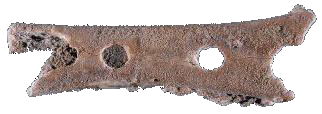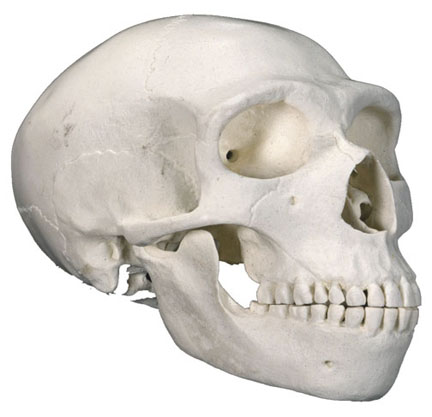![]() Neandertals did not leave much evidence of art in the archaeological
record. There are a few artifacts such as the polished mammoths tooth found in
Tata, Hungary, in 1964, and bones and rocks which that have scratches and faint
patterns on them. At the site of La Quina in France, pendants made from a
reindeer phalange and the canine of a fox were discovered. At the site of La
Ferrassie, a bone that was finely etched with long parallel lines was found near
a Neandertal burial. It has been speculated that perhaps it was placed there
intentionally. At another site, Bacho Kiro, in Bulgaria a fragment of a bone was
discovered with an unusual zigzag motif. When it was analyzed under a
microscope, it revealed that its maker, upon coming to the end of an engraved
line, "did not lift his tool to make a joining line in the other direction, but
left it on the bone and turned or twisted it, leaving the print of the turning
in the corner of each of the angles" (Marshack 1976:277). This indicates that
these marks were intentional and not casually made from butchering
Neandertals did not leave much evidence of art in the archaeological
record. There are a few artifacts such as the polished mammoths tooth found in
Tata, Hungary, in 1964, and bones and rocks which that have scratches and faint
patterns on them. At the site of La Quina in France, pendants made from a
reindeer phalange and the canine of a fox were discovered. At the site of La
Ferrassie, a bone that was finely etched with long parallel lines was found near
a Neandertal burial. It has been speculated that perhaps it was placed there
intentionally. At another site, Bacho Kiro, in Bulgaria a fragment of a bone was
discovered with an unusual zigzag motif. When it was analyzed under a
microscope, it revealed that its maker, upon coming to the end of an engraved
line, "did not lift his tool to make a joining line in the other direction, but
left it on the bone and turned or twisted it, leaving the print of the turning
in the corner of each of the angles" (Marshack 1976:277). This indicates that
these marks were intentional and not casually made from butchering
![]() Another intriguing evidence of Neandertal art comes from Tata, Hungary.
In 1964 a carved and perfectly oval shaped section of a mammoth's molar was
discovered. It was big enough to fit in the hand and at one point had been
ochered red, possibly more than once (Marshack 1976). This unique piece of art
also contained evidence of extreme handling, which caused it to appear highly
polished and rounded. According to Alexander Marshack:
Another intriguing evidence of Neandertal art comes from Tata, Hungary.
In 1964 a carved and perfectly oval shaped section of a mammoth's molar was
discovered. It was big enough to fit in the hand and at one point had been
ochered red, possibly more than once (Marshack 1976). This unique piece of art
also contained evidence of extreme handling, which caused it to appear highly
polished and rounded. According to Alexander Marshack:
"There is clearly a rough cognitive-visual connection between flakes that are struck from a pebble core and plates sectioned from the tooth. But there is a profound qualitive difference. The materials are different and require other working strategies and sequences. But, more important, in working Paleolithic stone one plans for a functional edge. Here the artisan planned for a "non-utilitarian, "symbolic object" (Marshack 1976:278).
![]() Another form of art discovered, that was created by a Neandertal was a
pendant from Arcy-sur-Cure, France. This decoration was made out of bone and
has
Another form of art discovered, that was created by a Neandertal was a
pendant from Arcy-sur-Cure, France. This decoration was made out of bone and
has  clear markings on it. It
was discovered with the Saint Cesaire Neandertal. It seems to be an amulet of
some sort, that could have possibly been worn around a Neandertal's neck. This
same pendant was found with pierced animal teeth, in what appeared to be a hut.
Some archaeologists suspect that this pendant is evidence of interaction between
Neandertals and Cro-Magnons. Either way, one can be assured that the amulet held
some sort of symbolic value to its owner.
clear markings on it. It
was discovered with the Saint Cesaire Neandertal. It seems to be an amulet of
some sort, that could have possibly been worn around a Neandertal's neck. This
same pendant was found with pierced animal teeth, in what appeared to be a hut.
Some archaeologists suspect that this pendant is evidence of interaction between
Neandertals and Cro-Magnons. Either way, one can be assured that the amulet held
some sort of symbolic value to its owner.
![]() All of the above items show that Neandertals possessed some artistic
ability and cognitive ability for abstraction, modeling, and manufacturing
something other than tools (Marshack 1976). These objects could have been
symbolic of numerous things. The pendants and mammoth tooth could have served as
markers in culturally structured intragroup relations, differentiating age, sex,
role, and rank representations (Marshack 1976). They also might have been used
in group activities such as rituals and ceremonies. Artifacts with zigzag images
were possibly symbolic of the awareness of the natural world.
All of the above items show that Neandertals possessed some artistic
ability and cognitive ability for abstraction, modeling, and manufacturing
something other than tools (Marshack 1976). These objects could have been
symbolic of numerous things. The pendants and mammoth tooth could have served as
markers in culturally structured intragroup relations, differentiating age, sex,
role, and rank representations (Marshack 1976). They also might have been used
in group activities such as rituals and ceremonies. Artifacts with zigzag images
were possibly symbolic of the awareness of the natural world.
![]() The ability of Neandertals to make music is another artistic quality
recently discovered. Announced in 1996, a flute made from a juvenile bear femur
with two intact pierced holes was found at the former Neandertal hunting camp of
Divje Babe I, in Slovenia (Wilford 1996). There were two other punctured holes
at the end of the bone, that either eroded away or were chewed off by
carnivores. The straight alignment of the holes suggests that they
The ability of Neandertals to make music is another artistic quality
recently discovered. Announced in 1996, a flute made from a juvenile bear femur
with two intact pierced holes was found at the former Neandertal hunting camp of
Divje Babe I, in Slovenia (Wilford 1996). There were two other punctured holes
at the end of the bone, that either eroded away or were chewed off by
carnivores. The straight alignment of the holes suggests that they  were made by
Neandertals using a carnivore tooth to pierce the bone, not by gnawing animals
(Wilford 1996). Could it be possible that Neandertal man was producing music?
According to this new discovery the answer is yes. This new discovery indicates
that Neandertals possessed the ability to produce music and possibly express the
prehistoric fears, longings, and joys in their lives, much like we do today.
This enforces the idea that Neandertals had basic human behavior.
were made by
Neandertals using a carnivore tooth to pierce the bone, not by gnawing animals
(Wilford 1996). Could it be possible that Neandertal man was producing music?
According to this new discovery the answer is yes. This new discovery indicates
that Neandertals possessed the ability to produce music and possibly express the
prehistoric fears, longings, and joys in their lives, much like we do today.
This enforces the idea that Neandertals had basic human behavior.
 Back to Home page
index
Back to Home page
index